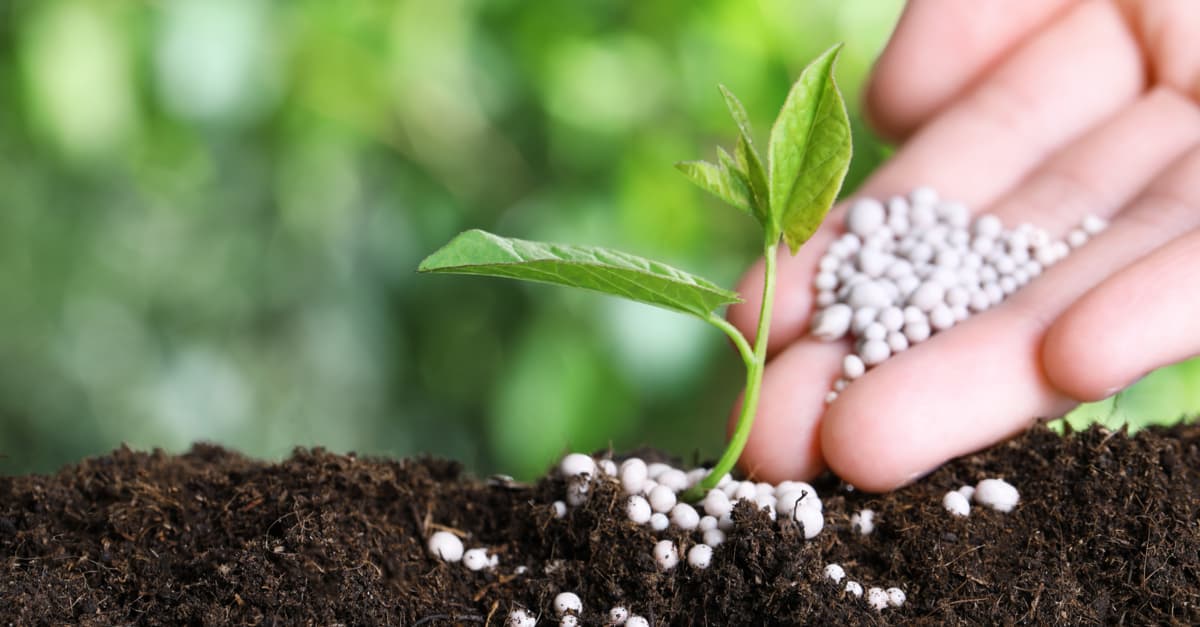Phân bón hóa học: Chi tiết lý thuyết và giải bài tập

Chemical fertilizers are indispensable catalysts in agricultural production, with the role of providing plants with essential nutritional elements, creating a bountiful harvest. In this article, Nguyễn Tất Thành will learn with you in detail about these types of fertilizers and guide you through detailed exercises in the textbook.
- Cách chia động từ Tell trong tiếng Anh
- Nhạc thai giáo tháng thứ 5 kích thích trí thông minh của trẻ
- Ảnh ảo là gì? Sự khác nhau giữa ảnh ảo và ảnh thật
- Những bài hát tiếng anh về mùa hè nổi bật và cách chúng giúp trẻ phát triển nhận thức, ngôn ngữ
- Cách học tên các môn học bằng tiếng Anh lớp 4 (kèm bài tập)
What is chemical fertilizer?
Chemical fertilizers (also known as inorganic fertilizers) are chemicals that contain many nutritional elements. They are applied to plants to increase crop productivity. Normally, soil becomes poor in nutrients as the plant grows. Therefore, plants need to absorb additional nutritional elements from the soil.
Bạn đang xem: Phân bón hóa học: Chi tiết lý thuyết và giải bài tập
The most common types of chemical fertilizers
Chemical fertilizers often contain nutritional elements necessary for plants, typically: P, Ca, N, K, Zn, Mg, Cu,… Based on different nutritional element compositions, They are divided into main types of chemical fertilizers, which are:

Chemical fertilizers – Nitrogen fertilizers
Nitrogen fertilizer is a widely used and extremely popular chemical fertilizer today. They play a role in stimulating growth, helping plants grow faster, producing many quality products such as seeds, tubers or fruits. Nitrogen fertilizer will provide nitrogen to plants in the form of Ammonium NH4+ and Nitrate NO3- ions. The percentage of Nitrogen in the fertilizer will determine the nutritional level of this chemical fertilizer. Below are the most common types of nitrogen fertilizers.

Ammonium nitrogen fertilizer
Ammonium nitrogen fertilizer is a product of ammonium salts, typically NH4Cl, (NH4)2SO4, NH4NO3…
Nature:
-
Easily soluble in water, making it easy for plants to absorb, and also easily washed away by water.
-
Its composition contains the base NH4+, so when exposed to water, it easily increases the acidity of the soil. Therefore, ammonium nitrogen fertilizer is not suitable for use with acidic soil.
To prepare ammonium nitrogen fertilizer, ammonia reacts with the corresponding acid.
For example: 2NH3 + H2SO4 → (NH4)2SO4
Nitrate nitrogen fertilizer
Nitrate nitrogen fertilizer is a product of nitrate salts such as NaNO3, Ca(NO3)2… This type of fertilizer is prepared by the reaction between nitric acid and carbonate salt.
Properties: Nitrate is highly soluble in water and flows very easily. Therefore, when applying nitrate nitrogen fertilizer to the soil, it has a quick effect on plants but is also easily washed away when exposed to rainwater.
For example: CaCO3 + 2HNO3 → Ca(NO3)2 + CO2 + H2O
Urea stool
Urea fertilizer with the chemical formula is (NH2)2CO containing up to 46% N, is the best nitrogen fertilizer today.
Urea fertilizer is prepared by reacting ammonia with CO2 at a temperature of 180 – 200 degrees Celsius and a pressure of about 200 atmospheres.
For example: CO2 + 2NH3 → (NH2)2CO + H2O (temperature, p)
Nature:
-
Urea is a white solid, very soluble in water and easily watery like other nitrogen fertilizers.
-
In soil, urea is decomposed under the action of microorganisms. The product created is ammonia or gradually turns into carbonate salt when exposed to water.
(NH2)2CO + 2H2O → (NH4)2CO3
From the information about the above chemical fertilizers, we have a table summarizing and comparing nitrogen fertilizers as follows:
| Nitrogen fertilizer | Ingredient | Ions absorbed by plants | Nature | Modulation |
| Ammonium | Ammonium salt NH4Cl, (NH4)2SO4, NH4NO3 | NH4+, NO3– | Soluble well in water, easy to dissolve. | Let ammonia react with the corresponding acid. |
| Nitrate | Nitrate salts NaNO3, Ca(NO3)2,… | NO3– | Soluble well in water, easy to dissolve. | MCO3 carbonate salt reacts with HNO3. |
| Urea | (NH2)2CO | NH4+ |
White solid, soluble in water.
Xem thêm : Dạy toán cho trẻ 5-6 tuổi giúp trẻ tư duy nhanh từ chuyên gia Has the highest N content.
|
Let CO2 react with NH3 at 180-2000C under a pressure of 200 atm. |
Chemical fertilizer 11 – Phosphate fertilizer
Besides nitrogen fertilizer, phosphate fertilizer is also an important form of chemical fertilizer. They provide phosphorus for plants during the growing period, promoting biochemical processes, metabolism, and energy exchange of plants. The nutritional level of phosphate fertilizer depends on the mass percentage of P2O5 in the composition.

Raw materials for producing phosphate fertilizer are apatite and phosphoric ore. The two most commonly used types of phosphate fertilizers today are: Superphosphate and fused phosphate.
Superphosphate
Superphosphate is divided into 2 types:
Single superphosphate
-
Contains 2 salts Ca(H2PO4)2 (easily soluble) and CaSO4 (insoluble, solidifies the soil).
-
Contains from 14 – 20% P2O5. They are prepared by reacting powdered phosphorite or apatite with concentrated sulfuric acid:
Ca3(PO4)2 + 2H2SO4 (concentrate) → Ca(H2PO4)2 + 2CaSO4 (precipitate)
Double superphosphate
-
Contains P2O5 content of 40-50%, because there is only Ca(H2PO4)2.
-
This type of chemical fertilizer is prepared in 2 stages:
Stage 1: Preparation of phosphoric acid
Ca3(PO4)2 + 3H2SO4 → 2H3PO4 + 3CaSO4 (precipitation)
Stage 2: Let phosphoric acid react with apatite or phosphorite
Ca3(PO4)2 + 4H3PO4 → 3Ca(H2PO4)2
Fused phosphate fertilizer
Fused phosphate fertilizer with main ingredients are phosphate and silicate of calcium and magnesium. They contain 12 – 14% P2O5, only suitable for acidic soils because this salt is insoluble in water.
Fused phosphate fertilizer is prepared as follows: Heating a mixture of apatite ore powder, sandstone and coke at a temperature of over 1000 degrees Celsius in a vertical furnace. The molten product is then rapidly cooled with water, dried and powdered.
From the information about the above types of chemical fertilizers, we have a table summarizing and comparing the types of phosphate fertilizers as follows:
| Type of stool | Ingredient | Plant ion assimilation | Modulation method | Content |
| Single superphosphate | Ca(H2PO4)2 and CaSO4 | H2PO4– | 14-20% | |
| Double superphosphate | Ca(H2PO4)2 | H2PO4– |
Stage 1: Preparation of phosphoric acid
Ca3(PO4)2 + 3H2SO4 → 2H3PO4 + 3CaSO4
Stage 2: Let phosphoric acid react with apatite or phosphorite
Ca3(PO4)2 + 4H3PO4 → 3Ca(H2PO4)2
|
40-50% |
| Fused phosphorus | Mixed phosphate and silicate of calcium and magnesium. | Melt a mixture of apatite ore powder, rhinestone (main component includes magnesium silicate) and coke in a vertical furnace at a temperature above 1000 degrees Celsius. | 12-14% |
Potassium chemical fertilizer
Potassium fertilizer is a form of chemical fertilizer that provides plants with the element potassium in the form of K+ ions. In agriculture, potassium chemical fertilizers are often used together with other fertilizers, helping to promote the production of fiber, sugar, and oils, increasing drought resistance, cold tolerance, and insect resistance. plant diseases. The nutritional content of potassium fertilizer is determined based on the mass percentage of K2O in the ingredients table.

KCl and K2SO4 salts are the most used ingredients in the production of potassium fertilizers. Plant ash containing K2CO3 is also considered a type of potassium fertilizer.
See more:
Mixed and complex fertilizers
Mixed and complex fertilizers are chemical fertilizers that contain several basic nutritional elements at the same time.

-
Mixed fertilizers (also known as NPK fertilizers): Their ingredients include: Nitrogen, Phosphorus, Potassium. For example, nitrophotka is a mixture of KNO3 and (NH4)2HPO4. Depending on the type of crop and soil type, people choose a fertilizer with the appropriate N:P:K ratio.
-
Complex fertilizer: A type of fertilizer that contains a mixture of substances created simultaneously by chemical interactions of substances. For example, when ammonia reacts with phosphoric acid, we obtain an amophosphate complex containing a mixture of NH4H2PO4 and (NH4)2HPO4 salts.
Micronutrients
Like “vitamins for plants”, micronutrients are a type of chemical fertilizer that provide plants with nutritional elements such as zinc, boron, copper, manganese, molybdenum, etc., helping to increase growth and metabolism. nutrients and increase photosynthetic efficiency of plants.

Micronutrient fertilizers are often applied to the soil in small amounts, combined with organic or inorganic fertilizers. Micronutrient fertilizers will only be effective for each type of plant and each type of soil. They will harm the plant if used at unreasonable amounts.
Exercises on chemical fertilizers in textbook 11 with detailed explanations
Join Nguyễn Tất Thành to apply the detailed knowledge about chemical fertilizers mentioned above to practice some exercises about chemical fertilizers in Textbook 11 below.

Lesson 1 (Chemistry textbook grade 11, page 58)
Give the following nitrogen fertilizer samples: Ammonium sulfate, ammonium chloride, sodium nitrate. Use appropriate reagents to differentiate them. Write the chemical equation of the reactions used?
Suggested answer:
We dissolve a little nitrogen fertilizer samples in water and get 3 salt solutions: (NH4)2SO4, NH4Cl, NaNO3. Slowly add Ba(OH)2 solution to each solution:
(NH4)2SO4 + Ba(OH)2 → BaSO4 ↓ + 2NH3 ↑+ 2H2O
2NH4Cl + Ba(OH)2 → BaCl2 + 2NH3 ↑+ 2H2O
Lesson 2 (Chemistry textbook grade 11, page 58)
From air, coal, water and necessary catalysts, create a diagram for preparing nitrogen fertilizer NH4NO3.
Suggested answer:

Lesson 3 (page 58 Chemistry Textbook Grade 11)
A phosphate ore containing 35% Ca3(PO4)2. Calculate the percentage of P2O5 in the above ore.
Suggested answer:
In 1000g of ore there are: 1000.35% = 350g Ca3(PO4)2
Conservation of element P ⇒ in 1 mol of Ca3(PO4)2 there is 1 mol of P2O5, which means that in 310g of Ca3(PO4)2 there is 142g of P2O5.
⇒350g Ca3(PO4)2 has the amount of P2O5 as:
m(P2O5) = 350 x 142 / 310 = 160.3g
% P2O5 in ore = 160.3 x 100% / 1000 = 16.03%
Lesson 4 (Chemistry textbook grade 11, page 58)
To produce an amount of amophosphate fertilizer, 6,000.10^3 mol H3PO4 is used.
a) Calculate the volume of ammonia gas (standard conditions) needed, knowing that this type of amophosphate has a mole ratio of nNH4H2PO4 : n(NH4)2HPO4 = 1 : 1.
b) Calculate the mass of amophosphate obtained.
Suggested answer:
Reaction equation:
H3PO4 + NH3 → NH4H2PO4
H3PO4 + 2NH3 → (NH4)2HPO4
⇒ Synthesis reaction equation:
2H3PO4 + 3NH3 → NH4H2PO4 + (NH4)2HPO4
a. From the reaction equation we have:
∑number of moles of NH3 needed = 1.5 number of moles of H3PO4 = 1.5 x 6 x 10^3 = 9000 (mol)
⇒ VNH3 (standard) = 9000 x 22.4 = 201600 (liters)
b. From the reaction equation we have:
nNH4H2PO4 = n(NH4)2HPO4 = 0.5.nH3PO4 = 0.5 x 6 x 10^3 = 3000 (mol)
Mass of amophosphate obtained:
mNH4H2PO4 + m(NH4)2HPO4 = 3000 x (115+132) = 741000(g) =741(kg).
If plants want to grow well, in addition to light and water conditions, they need to be provided with nutrients through chemical fertilizers. Hopefully the above article has helped readers gain more interesting knowledge about chemical fertilizers and effectively apply this information in life.
Nguồn: https://truongnguyentatthanh.edu.vn
Danh mục: Giáo dục





